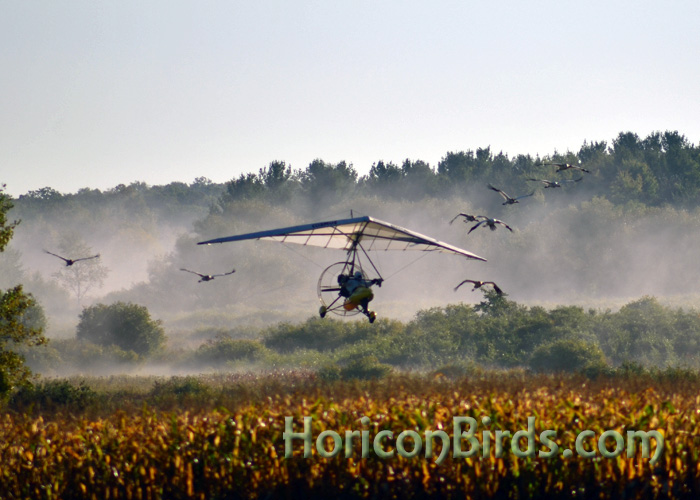|
Whooping cranes reach final stop on 2013 migration
by Pam Rotella
6 January 2014
HoriconBirds.com
Operation Migration reached St. Marks National Wildlife Refuge on Sunday, completing its 2013 guided whooping crane migration. Dozens of crane enthusiasts gathered at the Florida refuge to watch the arrival, while hundreds watched on the group's Ustream channels MigratingCranes and FlyingCranes.
The eight young cranes were penned and await permanent leg bands and final health checks. The birds will then be released into an open-topped pen, where they can fly out and gradually learn to live in the wild, returning to the pen as needed for food and protection. Pilot Brooke Pennypacker will remain at the refuge as a costumed handler until the young whooping cranes are ready to leave the pen.
|

|
Ultra-light Pilot Richard van Heuvelen leads young whooping cranes through daily flight training at White River Marsh in Wisconsin, September 2013. Photo by Pam Rotella.
|
The organization experienced more weather delays than usual in 2013, noted by Joe Duff in the group's Field Journal on the following day:
"When we left White River Marsh, all confident and enthusiastic, we were hopeful of short weather delays and skipped stopovers. But nothing erodes conviction like high winds. A month and a half later, we were still in Illinois and we spent most of December with wet feet... We were one day short of the longest migration ever and it was by far the coldest one we have experienced yet."
Operation Migration guides endangered whooping cranes through their first migration from Wisconsin to Florida. The captive-bred cranes are raised by costumed handlers to prevent imprinting on humans, and are trained to follow an ultra-light aircraft in order to learn a southern migration route from pilots.
Whooping cranes remain among the most endangered species in North America, with the last count finding 575 alive, only 415 of those in the wild.
All original content including photographs © 2013, 2014 by Pam Rotella.
|